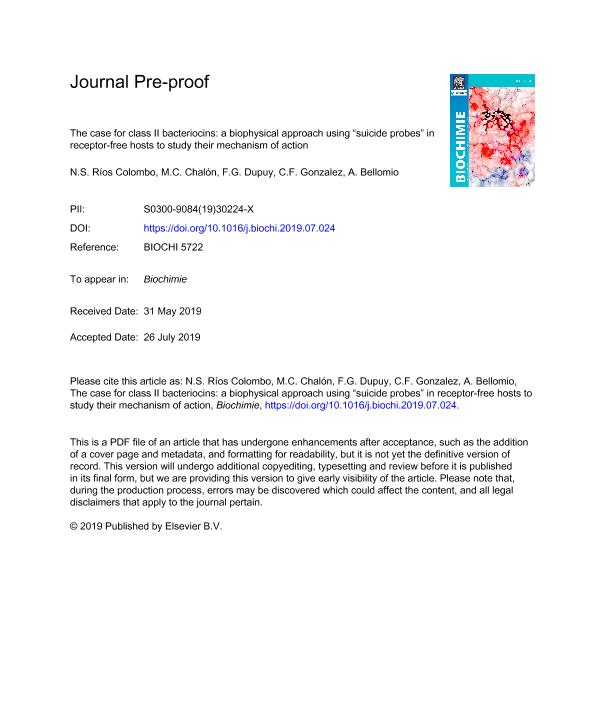Mostrar el registro sencillo del ítem
dc.contributor.author
Ríos Colombo, Natalia Soledad

dc.contributor.author
Chalon, Miriam Carolina

dc.contributor.author
Dupuy, Fernando Gabriel

dc.contributor.author
Gonzalez, Claudio Fabricio

dc.contributor.author
Bellomio, Augusto

dc.date.available
2021-01-06T16:45:02Z
dc.date.issued
2019-10
dc.identifier.citation
Ríos Colombo, Natalia Soledad; Chalon, Miriam Carolina; Dupuy, Fernando Gabriel; Gonzalez, Claudio Fabricio; Bellomio, Augusto; The case for class II bacteriocins: A biophysical approach using “suicide probes” in receptor-free hosts to study their mechanism of action; Elsevier B.V.; Biochimie; 165; 10-2019; 183-195
dc.identifier.issn
0300-9084
dc.identifier.uri
http://hdl.handle.net/11336/121621
dc.description.abstract
Class II bacteriocins are unmodified membrane-active peptides that act over a narrow spectrum of target bacteria. They bind a specific receptor protein on the membrane to form a pore, leading to membrane permeabilization and cell death. However, little is known about the molecular events triggering the pore formation after the bacteriocin recognizes the receptor. It is not clear yet if the pore is the same receptor forced into an open conformation or if the pore results from the bacteriocin insertion and oligomeric assembly in the lipid bilayer. In order to reveal which model is more suitable to explain the toxicity mechanism, in this work we use chimeric peptides, resulting from the fusion of the bitopic membrane protein EtpM with different class II bacteriocins: enterocin CRL35, pediocin PA-1 and microcin V. E. coli strains lacking the specific receptors for these bacteriocins were chosen as expression hosts. As these constructs display a lethal effect when they are heterologously expressed, they are called “suicide probes”. The results suggest that, indeed, the specific receptor would act as a docking molecule more than as a structural piece of the pore, as long as the bacteriocin is somehow anchored to the membrane. These set of chimeric peptides also represent an in vivo system that allows to study the interaction of the bacteriocins with real bacterial membranes, instead of model membranes. Hence, the effects of these suicide probes in membrane fluidity and transmembrane potential were also assessed, using fluorescence spectroscopy. The data show that the different suicide probes are able to increase phospholipid order and depolarize the membranes of receptor-free bacterial cells.
dc.format
application/pdf
dc.language.iso
eng
dc.publisher
Elsevier B.V.

dc.rights
info:eu-repo/semantics/openAccess
dc.rights.uri
https://creativecommons.org/licenses/by-nc-nd/2.5/ar/
dc.subject
LAURDAN
dc.subject
MICROCIN
dc.subject
PEDIOCIN
dc.subject
ENTEROCIN
dc.subject
MECHANISM OF ACTION
dc.subject
TRANSMEMBRANE POTENTIAL
dc.subject.classification
Biofísica

dc.subject.classification
Ciencias Biológicas

dc.subject.classification
CIENCIAS NATURALES Y EXACTAS

dc.title
The case for class II bacteriocins: A biophysical approach using “suicide probes” in receptor-free hosts to study their mechanism of action
dc.type
info:eu-repo/semantics/article
dc.type
info:ar-repo/semantics/artículo
dc.type
info:eu-repo/semantics/publishedVersion
dc.date.updated
2020-11-18T16:43:57Z
dc.identifier.eissn
6183-1638
dc.journal.volume
165
dc.journal.pagination
183-195
dc.journal.pais
Países Bajos

dc.journal.ciudad
Amsterdam
dc.description.fil
Fil: Ríos Colombo, Natalia Soledad. Consejo Nacional de Investigaciones Científicas y Técnicas. Centro Científico Tecnológico Conicet - Tucumán. Instituto Superior de Investigaciones Biológicas. Universidad Nacional de Tucumán. Instituto Superior de Investigaciones Biológicas; Argentina. Universidad Nacional de Tucumán. Facultad de Bioquímica, Química y Farmacia. Instituto de Química Biológica; Argentina
dc.description.fil
Fil: Chalon, Miriam Carolina. Consejo Nacional de Investigaciones Científicas y Técnicas. Centro Científico Tecnológico Conicet - Tucumán. Instituto Superior de Investigaciones Biológicas. Universidad Nacional de Tucumán. Instituto Superior de Investigaciones Biológicas; Argentina. Universidad Nacional de Tucumán. Facultad de Bioquímica, Química y Farmacia. Instituto de Química Biológica; Argentina
dc.description.fil
Fil: Dupuy, Fernando Gabriel. Consejo Nacional de Investigaciones Científicas y Técnicas. Centro Científico Tecnológico Conicet - Tucumán. Instituto Superior de Investigaciones Biológicas. Universidad Nacional de Tucumán. Instituto Superior de Investigaciones Biológicas; Argentina. Universidad Nacional de Tucumán. Facultad de Bioquímica, Química y Farmacia. Instituto de Química Biológica; Argentina
dc.description.fil
Fil: Gonzalez, Claudio Fabricio. University of Florida; Estados Unidos
dc.description.fil
Fil: Bellomio, Augusto. Consejo Nacional de Investigaciones Científicas y Técnicas. Centro Científico Tecnológico Conicet - Tucumán. Instituto Superior de Investigaciones Biológicas. Universidad Nacional de Tucumán. Instituto Superior de Investigaciones Biológicas; Argentina. Universidad Nacional de Tucumán. Facultad de Bioquímica, Química y Farmacia. Instituto de Química Biológica; Argentina
dc.journal.title
Biochimie

dc.relation.alternativeid
info:eu-repo/semantics/altIdentifier/doi/http://dx.doi.org/10.1016/j.biochi.2019.07.024
dc.relation.alternativeid
info:eu-repo/semantics/altIdentifier/url/https://www.sciencedirect.com/science/article/pii/S030090841930224X
Archivos asociados
